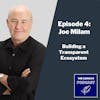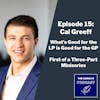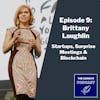Episode 4 - Building a Transparent Ecosystem with Joe Milam

The Venture Capital industry itself, for much of its history, has ironically lacked the innovation that it seeks to identify and fund. Joe Milam, the founder of AngelSpan and experienced family office and fund manager, chats with us about how VCs can learn from an institutional investor’s perspective to create needed controls around risk management, transparency, and professional standards that the industry sorely needs.
Professionalizing the Industry is An Enormous Opportunity
A big takeaway from our conversation was actually how easy it is to build these controls — much of the infrastructure is already in place with tools like AngelSpan. Joe had a front row seat to the growth of Angel investing and knows the ins and outs when it comes to areas of strength and weakness, which ultimately means the opportunities.
“And then all hell broke loose. It was called the commercialization of the internet. And from a front row seat…the Band of Angels, the first Angel group that sprung up after (that) was founded in my office…” – Joe Milam
Building a Transparent Ecosystem with Joe Milam
👋 Hey! Thanks for checking out the GoingVC Podcast: Uncovering new paths into VC, diving deeper into alternative models, and addressing areas of weakness every second Monday with Austin and JJ MacLean (@jjmaclean) from the GoingVC team.
We're really excited to be bringing to you today our conversation with Joe Milam. If you've got any questions, feedback, guest ideas, or just want to say hey, don't hesitate to shoot us a message at podcast@goingvc.com
Episode Chapters
- Joe’s Origin Story – 02:17
- The Startup Information Gap – 07:47
- AngelSpan – 09:24
- Building a Transparent Portfolio – 17:24
- Bell Mason Framework, a Rundown – 29:36
- Impact Investing: in the Eye of the Beholder – 34:40
- Joe’s Action Items – 36:56
The transcript has been edited and condensed for readability.
Joe’s Origin Story
Austin: [00:02:17] Let’s get started! You bring a lot of practitioner experience to what you guys are doing at angel spats. So why don’t we start with your background and then give us the high-level problem in venture, and then what AngelSpan you guys are doing about it?
Joe: [00:02:32] Yeah, I was a sort of a stock market junkie all the way back to college. Balance sheets just seemed to come naturally. I jumped off of the EF Hutton right out of college and found the sell-side is more about selling than analyzing. I had the good fortune to join a buy-side firm in 1990. That’s really where things changed dramatically. The firm I joined had been purchased by the Bank in Liechtenstein. They came to the US, opened an office in New York, and then started buying firms after the 1987 crash. They sought out the most boutique private client firm in the Bay Area, this one firm kept coming up, and they bought it in 1988. I had the good fortune of joining that firm in 1990, and we happen to be located at 3000 Sand Hill Road in Menlo Park.
My boss and predecessor was part owner of the complex. He grew up right over the Hill, went off to an Ivy League undergrad, Stanford MBA, and then entered the investment world in the mid-sixties and started his firm in 1970. When I joined in 1990, we were old school, doing our own research on individual securities, very much like a trust department at a bank. The first portfolio I was handed to manage was Larry Sonsini’s money. Sonsini of Wilson Sonsini Goodrich & Rosati. We had a couple of Sequoia Capital partner’s assets to manage as well because they were our neighbors. Danny was the guy that if you had money, you went to him. It was really through being his right-hand guy that I got early exposure to that old-guard of Silicon Valley. Reed Dennis, for example, was one of the old guard VCs. Reed and Danny went to the same prep school in Southern California; he hung out with them.
Sadly, Danny died of cancer in 1992, and I took over the business and bought back and took over the business in 1993. Then all hell broke loose. Hell being the commercialization of the internet, and we had a front-row seat through our clients.
The Band of Angels, the first angel group that sprung up after the internet, was founded in my office by Hans Severiens, who was my subtenant. It was the start of what I call a series of Forest Gump-like experiences that you couldn’t have made-up if you tried! It gave me direct exposure to the modern era of angel and venture funding, but from the perspective of a Wall Street type securities analyst and portfolio manager, and that experience informs what we’re doing now.
Austin: [00:05:05] Yeah, that’s interesting! You almost made it into venture by way of the right time, right place, right folks. But in your career, you stayed more tied to Wall Street for quite a bit while after that, right?
Joe: [00:05:21] Yeah! When Danny died, I took over the company. He and I were already talking about going off on our own when his five-year employment contract was to expire in July of 1993, and he sadly died Christmas Day of 1992.
I just grabbed the same people he and I talked about, repurchased the business, and launched off into what he and I discussed, only without him. We built a research methodology and process around a very singular philosophy and a third-party research tool called HOLT. It’s owned by Credit Suisse now and still headquartered in the same place, at the AT&T building in Chicago. You can think of it as a rigorous framework to analyze the fundamental operating performance of a company. HOLT recognized early-on how much GAAP accounting distorts earnings per share as an accurate reflection of what’s going on inside the business.
Even when you’re focusing on EBITDA and some of the other more expansive economic performance measures, those measures still don’t look at what’s going on the balance sheet, the assets being deployed to create that cash flow. That’s really where the Holt model was very robust. We started using it in the early nineties. I was a power user. When HOLT was sold to Credit Suisse, the company’s president hired me to manage his money. He sits on our board at AngelSpan now, and what we’ve created is a HOLT-like way to analyze private companies.
The Startup Information Gap
Austin: [00:07:05] Got it! You’re saying, okay, look, we have a lot of data in the public space, we can build models. What we don’t have is a lot of data, a lot of track records in the private space, and there’s an enormous opportunity to bring in a more rigorous framework for private investors. Could you walk us through how you bridged from one to the other?
Joe: [00:07:47] Yeah, sure! As I got active in angel investing myself, I saw firsthand how picking which startup to invest in and gaining access to information could be challenging. It just wasn’t the same as in public markets. A lot of it was based on hype, social signals, and who else is in the deal.
In the late 1990s, my clients started wanting to invest alongside me. I would make introductions, but as their fiduciary, I wouldn’t make recommendations because
- I am not a professional in that world.
- There just wasn’t enough information for me to make a recommendation.
So I made introductions, but even that fell apart, in large part because entrepreneurs were so notoriously bad at communicating after they had taken your money. I ended up halting both my angel investing and making introductions. However, I kept seeing this expansion of entrepreneurial activity. Both where I was located in Menlo Park, but even in places like Sacramento, which had always been considered a second or third-tier business city. I heard about it from across the country and the rise in entrepreneurship and a better way to fund it.
That became clear 25 years ago, so I started the company, the predecessor of AngelSpan, to build the toolkits that folks like me, who had investment experience, could use to take a more professional risk management portfolio management approach to the capital deployment process.
AngelSpan
Austin: [00:09:24] Can you tell me about those tools? I’m sitting here thinking that sounds amazing, but getting the data would be challenging?
Joe: [00:09:35] That is the heart of it! Many VCs say the best business startups do the hard stuff and that lack of information is the singular issue that’s holding back better and more investing in entrepreneurship.
The first thing we built with AngelSpan is the first Wall Street-like investor relations service for startups. Much like their public market equivalent, startups can hire us, and we make sure they’re communicating correctly to the outside world.
There’s actual science behind what is being reported, and this is the essential part. It’s called the Bell Mason Diagnostic. The Lean Startup Canvas was lifted out of part of the Bell Mason, addressing the operational milestones around finding product-market fit. But that’s just part of it. The Bell Mason diagnostic is a far more expansive and robust way to track all the things a startup should do from ideation to becoming a cashflow positive self-sustaining business. Gordon Bell, the principal architect, is an investor in AngelSpan. We have the inner workings of the diagnostic structured in the investor relations service, and the first step in it is getting good information, more signal, less noise.
Austin: [00:11:31] How challenging was getting off the ground? I imagine it was a nightmare to normalize that kind of data?
Joe: [00:11:41] It wasn’t! We didn’t recreate wheels; Mason’s already figured it out. They’ve got the scoring system. Many early operational milestones in a company’s life don’t show up in financial reports. Many things just show up as an expense: you file for IP, and you create a balance sheet asset, but it only shows up as a legal expense on the income sheet. A lot of the early process of building a startup is highly qualitative, and Bell created a scoring system to assign a numerical value to those to be quantified.
Austin: [00:12:36] Interesting! So is it safe to say the earliest-stage startups aren’t in your database because they don’t have any data yet at all?
Joe: [00:12:46] Yeah, we only score companies that hire us to do their IR. That’s how we get the data. When it comes to the type of startups, the ones that signup on the first-call tend to be from seasoned serial entrepreneurs. They’ve been there, done it, and know-how critical proper communications are.
First-time, recent college grads typically aren’t our clients. They don’t know what they don’t know. They don’t realize how difficult getting communications right can be and how important it is for their journey. However, they will sometimes come to us if they’ve managed to get enough traction with their seed round they’re raising an A, and their investors have beaten them over the head about never hearing from them!
Austin: [00:13:58] That makes sense!
JJ: [00:14:00] Could you expand on that last point? What’s the typical nudge? Is it they’re raising a new round, and as you said, better communications help deals close faster, or is the push typically from the investor side?
Joe: [00:14:20] That last point is really where we’re at. We always knew channel partners were going to be our core go-to-market strategy. Referrals from investors, angels, or anyone really who’s frustrated by the lack of information coming out of startups. We do trigger investments, and we get a lot of those use cases, but the problem is if they’re just coming to us for fundraising, they do not understand that this is a core corporate governance practice. You should be communicating because it’s the right thing to do, not because it will trigger an investment.
The evidence was that we went to many VCs and family offices, including the family that owns the San Antonio Spurs, and guess what; they never heard from the companies after they wrote them a check back. They heard about us, we got introduced, invested in us, and then referred us to all their portfolio companies, and not one of them signed up.
JJ: [00:15:47] Oh, wow!
Joe: [00:15:48] Yeah! Oh, wow! We had that happen with VCs as well. They’ll say, use AngelSpan if you want more money from us, and they don’t sign-up.
Austin: [00:15:56] Interesting! It seems like such an obvious step. Do you think it’s because they see it as a burden? They’re trying to change the world, and this is just another governance practice layer on top of them?
Joe: [00:16:05] There you go! They don’t want another expectation placed on them. They don’t understand how difficult this journey is or understand the roots of the relationship you have with investors.
To a certain extent, there’s a lot of what I call the Pitchfest Industrial Complex that produces these enabled entrepreneurs that are coddled and given all these free services because aren’t they, the rock stars? So they’ve been trained to think that way; they’re the center of the world, and investors are lucky to have them.
Going back to JJ’s question, we’ve found that yes, investors need to say, if you want my money use AngelSpan. When I see the third monthly update, then let’s sit down and talk. By the third-update, we’ll have created a Bell Mason score on them and contribute to the due diligence process. Not only that, but we’re building muscle memory so that entrepreneurs start seeing the benefits of the feedback they get. Investors love it; it’s standardized reporting. It’s not puff; it’s all signal, all information.
Building a Transparent Portfolio
Austin: [00:17:24] Yeah! If I am a venture capitalist, this sounds awesome! I’m getting standardized reporting that I don’t have to have in my back office, which. I frankly probably don’t have. I get some more transparency into my portfolio companies. Can you talk to us about the main benefits for GPs/LPs?
Joe: [00:17:46] Austin, I know I’m preaching to the choir on this with you, but most GPs don’t understand the things you just said. They’ve often spun out of a Google or a Facebook, they’ve got a ton of money, and they’re starting a fund now. They don’t understand the back office things or risk and portfolio management. Most of their investment decisions are based on who else is in the deal instead of objective analysis.
So you guys [GoingVC] are trying to create a curriculum and body of knowledge to help VCs be better investors, and our toolkit is to support that behavior for GPs or upcoming GPs that want to invest better. That don’t just want to throw together a fund and be part of the cool kid’s syndicate and co-invest with somebody else’s decision making process. They want to build a repeatable, disciplined process so when they’re raising their next-fund, they’ll have a track record.
Austin: [00:19:10] Yeah! Transparency is beneficial; having more information at your disposal should be a value-add?
Joe: [00:19:19] One would think! I know you guys know this, but there’s no standardized way to compute performance on a venture fund. It’s like the hedge fund world, a mysterious black box, don’t look behind the curtain. There’s a lot of Wizard of Oz stuff going on.
Austin: [00:19:36] From your perspective, what’s the most significant pain point that you run across is GPs who say they are diversified, they’re doing risk management, they do weekly calls, etc.? Where are you making the most inroads? What’s changing? For an industry that’s investing in innovation, the industry itself seems not to be innovative sometimes.
Joe: [00:19:57] That’s right. Tom Nicholas, who teaches entrepreneurship at Harvard Business School, wrote a book on the venture industry that came out last July called VC: An American History. It’s a beautiful book, and on page 311, he states what you just said. For an industry that funds innovation, there’s been remarkably little of it concerning how entrepreneurship is funded. The process and structure of a conventional venture fund look just like the first one that came out in 1959. I might be wrong, but I give credit to 500 Startups for saying, wait for a second, let’s just go in the exact opposite direction and diversify completely. That was a significant change. The innovation is coming.
What we’re doing, though, is merely bringing in proven practices from the public markets to the venture funding process, and it has to start with good information coming from the companies.
As an analogy, the way we invest in startups today is much like for public securities before the 1933 Securities Act. It’s all hot tips, and who else is in the deal? That’s literally what led to all the fraud and nonsense that compounded the Great Depression.
This is why, if you look at the 1933 Act. It’s about risk management; transparency is a risk management step. And then the 1940 Investment Company Act came out and said in a further risk management step; this is how you run a properly diversified investment pool: mutual funds, ETFs, and life.
There needs to be a ‘40-like Act for venture funds, so they’re adequately diversified with actual structure around it. This is the direction I was hoping things would go when we started AngelSpan seven years ago, and it’s starting to materialize.
Austin: [00:22:09] That makes sense! For anyone who doesn’t understand, the 1933 Act and 1940 Act were securities legislation that were developed after the 1929 crash to help improve transparency and higher regulatory standards so that investors could make better decisions. So that they’re not investing in something with more risk than what appears to be the case.
Joe: [00:22:28] Right! And that’s why we built AngelSpan so that investors can understand and manage their risk, by first and foremost, expecting proper transparency before you write the check.
Austin: [00:23:01] How has it gone so far? Is there proof in the pudding?
Joe: [00:23:10] We launched AngelSpan in January 2014, so we’ve got useful longitudinal data, but we’ve only touched 250 or so startups in our work here over the last six years. There is a lot of other research out there, however. Gordon did backtesting for thousands of companies while calibrating the probability of a successful outcome.
Another piece is a report that came out from a university in the UK working with a VC firm studying the link between transparency and success. They’ve got a robust data sample, and it shows that when there’s proper transparency, it’s highly correlated with startup success.
If you want to improve your batting average, think of that optimal Moneyball statistic. Stop listening to a pitch, and look at the data. Jason Calacanis talks about it, a lot of other people have anecdotally told me that it’s true as well, but this report put some real data behind it. If you start with evidence of real proper transparency, your success of investing will go through the roof.
JJ: [00:24:38] Cool! How do you take that and then build a portfolio? How do you figure out the right number of companies, the right check size, that sort of thing? And a little off-topic, but I’d be curious to add to that your thoughts on AngelList Rolling Funds and other open-ended funds as well.
Joe: [00:24:53] 500 Startups has done some excellent research on this, AngelList as well. It’s directionally like an open-ended mutual fund. Now, of course, I still want to go back and make sure that the portfolio is appropriately diversified and they’re staging investments over multiple rounds. That they’re not just leaving it open to attract new money and add a single investment. Architecturally it’s like an open-end mutual fund, but it still comes down to, are you diversifying properly? Are you managing non-systematic risk, which is only through diversification, and then systematic risk, which is timing or thesis risk. And that’s only done through multiple funding rounds and dollar-cost averaging.
Austin: [00:25:34] Yep! To pause again, two important terms:
- Non-systematic risk is specific company risk.
- Systematic-risk is a risk that comes from just being invested in the market, the macro factors.
Every good money manager’s goal is to eliminate those company-specific risks by not being overexposed to a single event from a single company. This is ironic given that in venture capital, most would go; I want to find that unicorn.
Joe: [00:26:01] 500 Startups has done some great work on this; they’ve got a robust data sample from all the companies they’ve invested in and were able to, with the benefit of hindsight, model out an optimal portfolio strategy. They found that an optimally diversified seed-stage portfolio has between one hundred and two hundred companies, all with equal dollar-weighted amounts.
Austin: [00:26:42] That’s very different from the traditional 18 or 20 in public markets. I would imagine because there’s a lot of different types of risk?
Joe: [00:26:51] Exactly! You’ve got all sorts of risks that are compounded in the private market lifecycle. Now, A round companies were between 60 and 120, and B round was between 30 and 60. That makes sense; they’re more mature, so you need less diversification. If you compare B round to that public number you just said, it makes sense intuitively there’s still greater operation risk, liquidity risk. Needing twice the diversification makes sense.
Despite all this data, though, people will still say, “I’m going to build a properly diversified portfolio of 25 companies.”. I just laughed my tail off. They don’t know where that number comes from and they’re certainly not basing on actual, proper diversification. The people who are launching and running 90% of the venture funds out there don’t have that experience. They don’t want those professional standards and behaviors to enter the venture asset class because now you’re literally professionalizing it. You’re raising expectations. You’re raising the ability to hold them accountable.
Austin: [00:28:13] Do you think that hurdle is too high?
Joe: [00:28:14] That’s a great question! Let’s just say it’s felt like a quixotic quest, the last seven years, but I can tell you people are talking about it. There’s a narrative down to the CAIA organization about bringing professionalism to it. There are even discussions about a certification process, as a CFA for venture capital general partners.
Austin: [00:28:38] Got it! So that everyone knows CAIA is the certification of the alternative investment industry, right?
Joe: [00:28:43] Yeah! Everything that’s not publicly traded, real estate, oil and gas, private equity, venture capital. It’s being driven in part by the pension plans out there, the institutional fiduciary driven money that has developed a real under-funding problem. Meaning they’re largely bankrupt. Nobody knows this better than Illinois or Chicago, but they all are. They have a return expectation that’s not going to be met in the public securities, so there are tens of trillions of dollars that need to find a better return.
Bell Mason Framework, a Rundown
JJ: [00:29:36] Quick question before we continue, just so the listeners are all on the same page. Could you give a quick rundown on what’s included in the framework? The types of data points you collect in AngelSpan?
Joe: [00:29:49] Yeah! The four main pillars of any business are team, product, market, and operations. In-turn, under each of those, is granular sub-categories:
- Market: the market itself, the business plan, and marketing/sales
- Team: the internal leadership team, the internal operating team, and external leadership team (board of directors and advisory board)
- Product: can you build it, deliver it, and protect it?
- Operations: funding but also accounting and legal
All of these, of course, have granular milestones underneath them for each of the five natural life-cycle states of a company:
- Concept stage–you’re coming up with something.
- Seed stage–early team and defining a conceptual MVP
- Alpha stage–used to be named the, A round stage or product development stage; this is where you take that round seed money, build that MPP, and start testing it—finding that product-market fit.
- The B round–now called the beta stage, you’ve iterated on product-market fit. You’ve got a repeatable sales process. You’ve got validation of at least your V1 feature set and value proposition pricing; you’re now taking it to market at scale.
- Liquidity stage–the company is cash-flow positive and growing like crazy.
That last part is essential; they’re cash-flow positive. You find your unit economics in the alpha/product development stage. You might not be cash-flow positive in the product development stage, but you’ve discovered unit economics that makes sense.
Companies like Uber went public before ever leaving that product development/alpha stage. Those stages don’t correspond to funding levels but instead tangible operational milestones.
Austin: [00:32:17] You bring up a very interesting dynamic–returns on paper versus actual wealth generation. GPs can get rich on paper, collect their management fees, all before the LPs see that much. I think what you’re proposing is let’s invest in companies that will turn a profit, have an exit event, and realize some returns for our investors?
Joe: [00:32:43] Correct! Think of it like building a building. If you’re a property developer–you line up construction financing and then start pushing dirt around. You’re converting cash to deliver operational milestones. You turn that dirt into incrementally more valuable dirt, and then a piece of the building. At some point, the building inspector and if they sign off that it’s been done properly, the next tranche of financing is released.
That would be the ideal way to deploy capital in startup land as well.
You don’t want to throw a bunch of money at the Adam Neumann’s of the world, or the Theranos’, the blood-testing company, right? The cautionary tales are clear, and a way to manage that better is to deploy capital incrementally based on milestone accomplishments. You’d not only be managing risk better, but you’d also be mobilizing more capital because the risk is being managed better.
Austin: [00:33:53] But… that means FOMO taking a back seat…
Joe: [00:33:59] That’s right. You asked earlier about what’s going to be the most challenging part of professionalizing the industry? That’s it. It’s going to have to come from the money (LPs). Money needs to flow to where real value creation is taking place, not financial engineering or hype. The hurdle rate is so low that the opportunities are enormous. The money needs to go here, and when deployed correctly, you can participate in the actual value creation process.
Impact Investing: in the Eye of the Beholder
JJ: [00:34:40] That’s well said! Changing gears again for a bit, you alluded earlier to how different levers people can pull on to drive value, and one of them is impact investing. We had a great conversation about this in a previous episode (Episode #2–Nettra Pan), but I’d love to hear your take on it. What’s your perspective on impact investing?
Joe: [00:35:03] That’s a great question! The best definition I’ve heard was by Jean Case. She was speaking at the Milken Institute event several years ago, about four years ago. You can see it on YouTube.
She opens it up by saying, what is an impact company?
- They’re committed to transparency.
- They are committed to measurement.
- They’re committed to impact.
Now that’s admittedly a pretty generic definition, and a guy raises his hand in the audience and says: I get the first two, but committed to impact? I’m a reasonably normal startup, but we choose to open in Baltimore because the region needs more job creation.
Her answer was perfect: For the people of Baltimore, you are, and that’s the critical point.” The impact is the eye of the investment. The tip of the sword for wealthy families is place-based impact investing, which is creating economic vibrancy in these overlooked communities around the country. That’s important when most creative innovation and venture activity occur in the same four cities.
It’s why we had the Opportunity Zone legislation a few years ago and why Amy Klobuchar has introduced new legislation, supported by Nancy Pelosi and Mitch McConnell of all people, that’s trying to get the government to deploy early-stage funding in communities across the country. The issue of impact is really in the eye of the beholder.
Joe’s Action Items
Austin: [00:36:56] That’s an exciting point and something we could riff on for hours, but to make it practical–what are some small things that GPs could do today to move towards a more professional industry?
Joe: [00:37:14] Well, let’s presume they want to–let’s call them the alums of GoingVC who are by definition trying to do it better. I got to shout out to you guys; because why hasn’t the National Venture Capital Association (NVCA) done it already? Why didn’t they do it thirty or forty years ago?
I bring this up to give you guys credit and help you understand why venture capital isn’t a profession yet. The NVCA is a lobbying organization. It hasn’t created a body of knowledge or best practices or had conversations like this, and they’ve been around since 1973.
Anybody can become a VC. You raise some money and pay a lawyer to do the legal work, and you’re now a VC. You just have to submit a couple of bucks and pay a lawyer to form the legal document. But, with that in mind, let’s say a GoingVC alum that wants to do it better. What should they do first?
Again, this is a bit of talking out of my own book, so I want to be careful here, but this is a space I’ve been studying a long time–it starts at transparency at both the company level and the fund level.
A lot of funds are pretty opaque with their thesis and strategy. Getting your own back office house in order isn’t sexy or fun, but it is what professionals do. Next is understanding what your thesis is. There’s a lot of great work out there; Daniel Kahneman has some, 500 Startups has some. Do your homework; you can even just say I am doing it this way because these guys said this is a great way to do it.
That alone would set you above virtually every other GP. Because they’re all going to try and make it very mystical, based on how smart they are or how impressive their Rolodex is, and they can’t be accountable to any of that. When you’re basing it on a disciplined, rigorous, transparent process, then you can be accountable, and that makes you more professional. And of course, you’ve got to expect the same from your portfolio companies. That’ll improve our batting average and ability to do proper follow on funding so that you can manage systematic risk better. Then next, you’re going to diversify properly. You can’t predict the future or know what’s going to be hot.
The irony is that the bar to professionalize is so bloody low right now. It’s not hard to create a more professional venture fund strategy by deploying other people’s research. And you’re not showing your own arrogance. You’re not relying on social signals or the purported quality of access to deal flow. You can’t pitch that and launch that fund in St. Louis because there is no deal flow in St. Louis, but you can manage the fund I just described from St. Louis. You can ask a bunch of accelerators to send you all the companies that are good at reporting.
Austin: [00:41:21] Right! You’re setting a good foundation here that makes a lot of sense. This has been tremendously valuable. I hope everyone who listens to this has gotten a new perspective on the venture capitalist’s role. It’s not just about finding the next unicorn. There’s a lot more to being a great VC that sets many of those in the 2% apart. Having the network is a great value add, but it’s a value add. It’s not a core competency.
Joe: [00:41:48] Right! It’s not a core competency because you’re instantly going to lose that game. You’re setting yourself up to fail. One last thing I would add is to study the word fiduciary and understand what it means when you take somebody else’s money. Whether you’re a GP taking LPs money, or you’re an entrepreneur taking an investor’s money. You are now a fiduciary over somebody else’s money. Understand what that responsibility means before you write or take the check.

Joe Milam
Founder at AngelSpan
Joe has a background in financial analysis, portfolio design, and management, financial markets, angel investing. He's now applying his 29 years of working as a securities analyst/money manager/philanthropy consultant to address the inefficiencies in the entrepreneurial funding ecosystem. At AngelSpan, we are addressing the chronic 'information gap' typical with early-stage companies by delivering the best in class Investor Relations.
New to The GoingVC Podcast?
Here are some great episodes to start with. Or, check out episodes by topic.



































